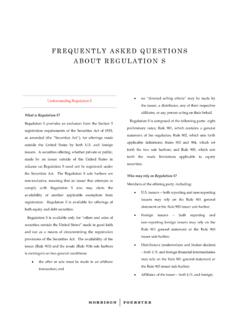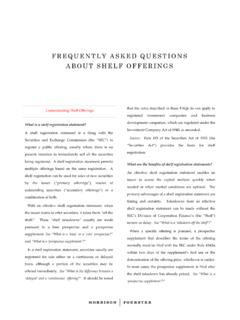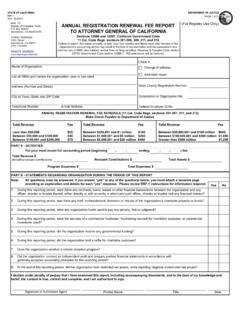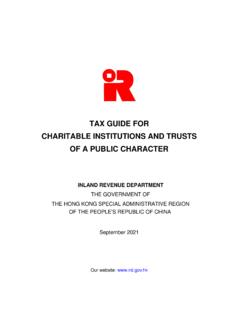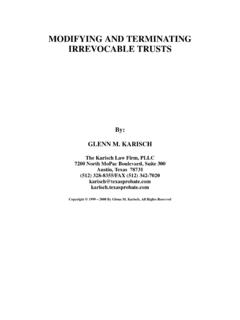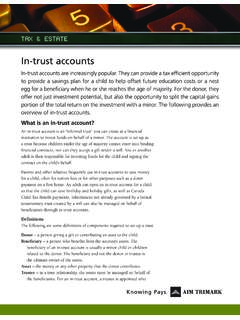Transcription of Frequently Asked Questions about Real Estate Investment …
1 Frequently Asked Questions about REAL Estate Investment TRUSTSReIT BasicsWhat is a REIT?The term ReIT refers to a real Estate Investment trust as set forth in subchapter M of chapter 1 of the Internal Revenue Code of 1986 (the Code ). An entity that qualifies as a ReIT under the Code is entitled to preferential tax treatment. It is a pass-through entity that can avoid most entity-level federal tax by complying with detailed restrictions on its ownership structure, distributions and operations. ReIT shareholders are taxed on dividends received from a ReIT. See Tax Matters below for more and why were REITs created?Congress passed the original ReIT legislation in 1960 in order to provide a tax-preferred method by which average investors could invest in a professionally managed portfolio of real Estate assets.
2 Many of the limitations imposed upon the operation of ReITs and the taxes to which they are potentially subject are perhaps best understood in terms of the original notion that the activities of ReITs were to consist predominantly of passive investments in real are the required elements for forming a REIT?In order to qualify for the tax benefits available to a ReIT under the Code, the qualifying entity must: have centralized management (Code Section 856(a)(1)); have transferable shares (Code Section 856(a)(2)); be a domestic corporation for federal tax purposes(Code Section 856(a)(3)); not be a financial institution or insurance company(Code Section 856(a)(4)); have shares beneficially owned by at least 100persons (Code Section 856(a)(5)); not be closely held (Code Section 856(a)(6)); satisfy annual income and assets tests (Code Section856(a)(7)).
3 Satisfy distribution and earnings and profitsrequirements (Code Section 857(a), Code Sections561 through 565); make a ReIT election (Code Section 856(c)(1)); and have a calendar year tax year (Code Section 859).What are the required elements for maintaining REIT status?An entity that wishes to maintain its status as a ReIT must satisfy the requirements described under What are the required elements for forming a REIT? for each year in which it wishes to so qualify, subject to the following exceptions: The entity must satisfy the 100 or more beneficialowner test only on at least 335 days of a taxable yearof 12 months in which it wishes to qualify as a ReIT,or during a proportionate part of a taxable year ofless than 12 months; The requirements that a ReIT have at least 100beneficial owners and that it not be closely held do not apply to the first taxable year for which aReIT election is made; The requirement that a ReIT not be closely heldmust be met only for the last half of each & Foerster LLP Capital MarketsWhat types of REITs are there?
4 Most broadly, there are equity ReITs that own primarily interests in real property and mortgage ReITs that own primarily loans secured by interests in real property. equity ReITs typically lease their properties to end users and may concentrate on a market segment, such as office, retail, commercial or industrial properties, high end or middle market segments or a specific industry segment such as healthcare or malls or lodging. Mortgage ReITs may also have a focus on particular types of loans (first mortgages, distressed property mortgages, mezzanine financings) or borrowers. Hybrid ReITs are relatively rare and own a combination of equity and mortgage interests in real property.
5 In recent years, the IRS has approved ReIT status for businesses not traditionally associated with the ReIT structure, such as billboards, data centers, cell tower companies and private correctional an equity REIT a commodity pool?According to a 2012 interpretative letter from the Commodity Futures Trading Commission (the CFTC ),1 an equity ReIT is not a commodity pool and therefore, is not subject to the Commodity exchange Act if the equity ReIT meets the following conditions: the primary income of the ReIT comes from theownership and management of real Estate and itonly uses derivatives for mitigating exposure tointerest rate or currency risk; the ReIT complies with all the requirements of aReIT election under the Code, including the 95%and the 75% income test (Code Sections 856(c)(2)and 856(c)(3)).
6 And the ReIT has identified itself as an equity ReITin Item G of its last income tax return or, if ithas not filed its first tax return, it has expressed itsintention to do so to its participants and effectuatessuch a mortgage REIT a commodity pool?According to a 2012 interpretative letter from the CFTC ),2 while a mortgage ReIT is considered a commodity pool, the Division of Swap Dealer and Intermediary Oversight will not recommend that the CFTC take enforcement action against the operator of a mortgage ReIT that satisfies the following criteria:1 CFTC Letter no. 12-13, see CFTC Letter no. 12-44, see limits the initial margin and premiums requiredto establish its commodity interest positions to nomore than 5% of the fair market value of the ReIT stotal assets; limits the net income derived annually from itscommodity interest positions that are not qualifyinghedging transactions to less than 5% of the ReIT sgross income; interests in the ReIT are not marketed to the publicas or in a commodity pool or otherwise as or ina vehicle for trading in the commodity futures,commodity options, or swaps markets.
7 And the company either has identified itself as a mortgage ReIT in Item G of its last incometax return or has not yet filed its first income taxreturn but has disclosed to its shareholders that itintends to so identify no-action relief is not self-executing, and themortgage ReIT must file a claim to perfect the use of the relief. Any such claim will be effective upon filing, so long as the claim is materially other countries have REITs?A number of countries, including Australia, Brazil, Bulgaria, Canada, Finland, France, Germany, Ghana, Hong Kong, India, Japan, Malaysia, Mexico, nigeria, Pakistan, Philippines, Saudi Arabia, Singapore and the united Kingdom have ReIT-type legislation.
8 The details of the rules may vary from the rules and from country to a ReITHow is a REIT formed?A ReIT is formed by organizing an entity under the laws of one of the 50 states or the District of Columbia as an entity taxable as a corporation for federal income tax purposes, and by electing to be treated as a ReIT. An entity may elect to be treated as a ReIT for any taxable year by filing with its tax return for that year an election to be a ReIT. The election generally remains in effect until terminated or revoked under Code Section 856(g). The election is made by the entity by computing taxable income as a ReIT in its return for the first taxable year for which it desires the election to apply (generally on Form 1120-ReIT), even though it may have otherwise qualified as a ReIT for a prior year.
9 No other method of making such election is permitted. See Treasury Regulations Section (b). 3 What types of entities can be REITs?Any entity that would be treated as a domestic corporation for federal income tax purposes but for the ReIT election may qualify for treatment as a ReIT. under the ReIT regulations, the determination of whether an unincorporated organization would be taxable as a domestic corporation in the absence of the ReIT election is made in accordance with the provisions of Code Section 7701(a)(3) and (4) and the regulations thereunder. The net effect of these rules is that an entity formed as a trust , partnership, limited liability company or corporation can be a ReIT.
10 Publicly traded ReITs are typically corporations or business are REITs typically formed?Most publicly traded ReITs are formed as trusts under the Maryland ReIT law or as corporations under Maryland law. Many, if not most, non-ReIT public companies prefer to be incorporated or formed under Delaware law because of its well-developed corporate law and a judicial system designed to be responsive to corporate law issues. However, Maryland has a specific statute for ReIT trusts and has developed an expertise in such law. unlike the relevant Delaware law, the Maryland ReIT law provides that a ReIT may issue shares of beneficial interest without consideration for the purpose of qualifying it as a ReIT under the Code, and unless prohibited in the declaration of trust , a majority of the entire board of trustees, without action by the shareholders, may amend the declaration of trust .

